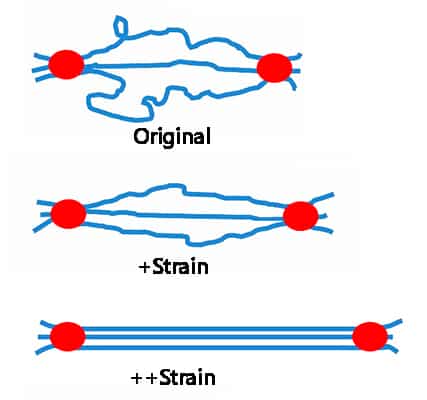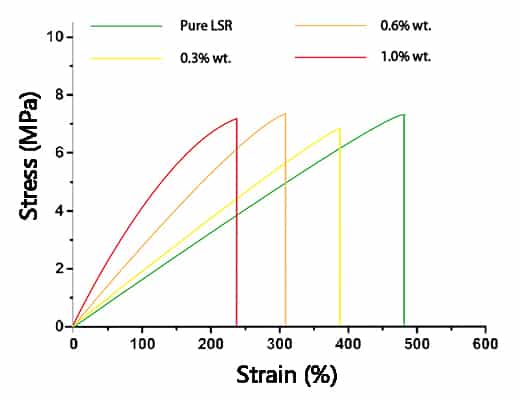Liquid silicone rubber fillers are normally applied to enhance LSR mechanical properties, in order to improve certain properties for application with requirements. LSR is the most important synthetic elastomer, it is easy to process with excellent properties. There is a significant advantage of LSR materials over conventional elastomer materials, it doesn’t require high complex compounds to achieve optimal properties for final products.
Common Silicone Rubber Fillers
Although silicone rubber filler is applied originally to decrease conventional rubber cost, its secondary effect is improving strength and toughness. Furthermore, these fillers must have inherent mechanical properties and interact with the silicone rubber, in order to guarantee the effective properties improvements.
In this case, the common silicone rubber fillers have characteristics as following:
- Large surface-area to volume rate, or high proportions between the width and length.
- Micro-size with nanoscale dimension.
- Different shapes of flakes, fibers, spheres, tubes.
The most common silicone rubber fillers are:
- Precipitated silica
- Fumed silica
- Montmorillonite
- Zinc oxide
- Titanium dioxide
- Glass
- Graphene
- Carbon black
In some case, carbon black is both reinforcing filler and color pigments. It is a common reinforcing fillers in conventional elastomer materials. We should also notice that color silicone compounds have different mechanical properties, in reason of the pigment additives.
Furthermore, in terms of eco-friendly material, cellulose fibers are attractive options due to low density, bio-compatibility, and biodegradability. These silicone fillers are normally in the form of microcrystalline cellulose (MCC), this is easy to produce by adding strong mineral acids.
The amount of silicone rubber fillers have an impact on final LSR density. Therefore, we need to find the optimal value of fillers percentage in liquid silicone rubber compounds. In order to, don’t sacrifice the inherent low density of silicone rubbers.
How Silicone Rubber Fillers Work?
From the previous information, we can notice that the silicone rubber fillers will increase mechanical properties of liquid silicone rubber (LSR) into a high level.
Reinforcement Effect of Silicone Rubber Fillers
This reinforcement effect is a complex result of different phenomena, process and mechanism in molecular level. We can simply this effect as following:
- Liquid silicone rubber compounds consist of two main phases after curing: rigid micro particles, liquid silicone rubber molecular networks.
- Rigid micro particles will influence the mechanical behaviors by surface or inter-facial contact. Therefore, the inter-facial bonding is created between the particles and LSR materials with physical or chemical bonds. Depends on the intensity, energy and property of bonds, these bonds will give rise to the final increase in mechanical properties.
- Normally, the properties and shape of fillers will create chemical interaction of inter-facial bonding between LSR materials. As expected, this higher of interaction will result in higher mechanical properties. Furthermore, this interaction will also affect other properties of wet-ability and adhesion.
- However, if the inter-facial bonding is weak or low, the silicone rubber fillers will have the opposite influence. This will give rise to stress concentrations and low load transfer, finally result in poor mechanical properties of liquid silicone rubber.
Once, we apply a microscope to the interaction between silicone rubber fillers and liquid silicone rubber compounds. This interaction stabilizes the location of filler particles. Therefore, this is a clear sign of improvement in the dynamic mechanical properties.
Mechanism of Reinforcement
There is a mechanism graph of reinforcement as following:

- At original phase, the chains in LSR are in an equilibrium state. In reason of possible molecular interaction between liquid silicone rubber compounds, there are entanglements in molecular area. Between these chains, micro reinforcing particles are existed.
- Once strain stress is applied, the chain segments start to move, then the network begins to move. In order to accommodate the changing conditions. In reason of redistribution of stress in stretched chains, molecular rupture is prevented. This results to the first part of mechanical properties’improvement of LSR compounds.
- As strain stress increases to a higher level, the inter-facial bonding between the silicone rubber filler and silicone chains will create additional movement restriction. Therefore, this gives rise to a second parts of increase in mechanical properties, we call this as strain hardening.
Mixing Methods of Silicone Rubber Fillers
Once we consider the mixing methods of silicone rubber fillers, there are two typical ways: dispersed particles or particle agglomeration (particles in clusters). Normally, the mechanical response requirements in LSR compounds determine the final preferred method.
In generally, we choose the micro particles with similar size to distribute throughout the composite homogeneously. However, in some case, particle clusters with controlled sizes can increase mechanical properties with easy processing of LSR materials.

From the above graph, we can notice the comparison of reinforcement effect between discrete particles and particle clusters in Liquid Silicone Rubber (LSR). Both these two fillers will increase the reinforcement as fillers concentration increase. But discrete particles have higher reinforcement than particle clusters with the same concentration.
Mixing Methods with LSR
When we add silicone rubber fillers into liquid silicone rubber, there is not only mechanical properties changes, but also effect on process behavior of viscosity. The higher concentration of fillers will increase the viscosity. Therefore, we should address this issue of mixing.
Once we apply nanoparticles as fillers, we need to improve the dispersive and distributive mixing in LSR matrix. In order to improve the binding force between LSR materials and fillers. There are several mixing methods to improve the mixing as following:
Melt Compounding
This is the most common mixing method, silicone rubber fillers are added into an extruder, and combine with the LSR materials.
Kneader Dispersion
Silicone rubber fillers and LSR materials are loaded into a mixing chamber. Then the rotor with a spiral annular design will mix these compounds by shear forces. Temperature control is required in this method.
Ultrasonic Coupling Rrotation-revolution
This rotation-revolution will generate a centrifugal force of 400 G in the opposite direction, in order to make the LSR flow spirally for homogeneous mixing.
Surfactant Modification
Depends on the filler options, select suitable chemical compounds to deposit on silicone rubber filler surfaces. In order to decrease the surface energy and improve the aggregation of fillers. This method also can increase the compatibility with LSR materials.
Chitosan Salt or Graphene Assisted Dispersion
Chitosan slat or graphene are applied to prevent filler agglomeration, then dissolution LSR materials into the solvent with silicone rubber fillers. Mix and ultrasonicate this suspension, and then solidify under vacuum.
Reinforced Liquid Silicone Rubber Processing
It is a challenge to process reinforced liquid silicone rubber (LSR), even tiny changes in silicone rubber fillers of transition temperature, softening temperature, and curing behavior will result in significant production issues. Therefore, we need to perform a previous characterization analysis and simulation to identify changes and make modifications in processing.
Furthermore, we should produce the compounding of LSR with fillers carefully, especially with Nano-size fillers. In order to optimize the efficiency, quality and cost.
Miwo is a reputable and experienced LSR molding company, we are one of the largest manufacturer in China, specialized in high-volume, precise LSR molded parts. We provide our LSR injection molding, over molding and 2-shot molding for customers in worldwide. Our LSR products are popular in medical, healthcare, infant care, electronic, automotive and other industries.
Contact us now for more information about reinforced LSR materials.